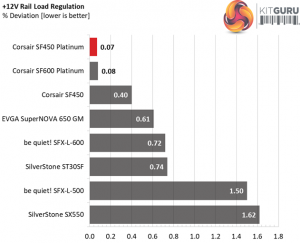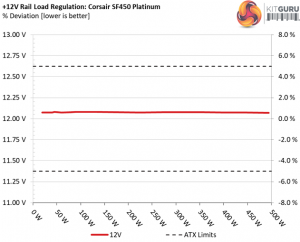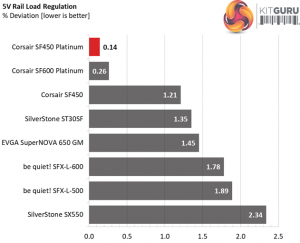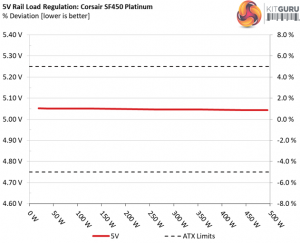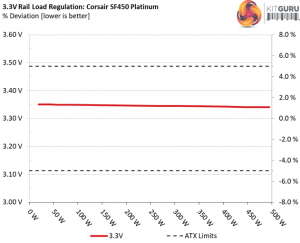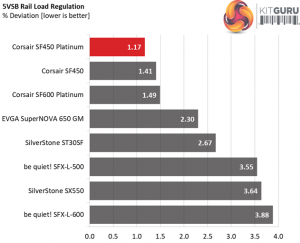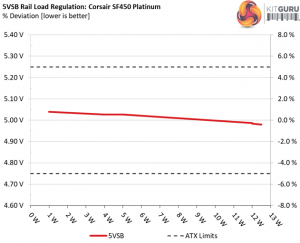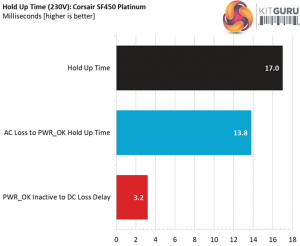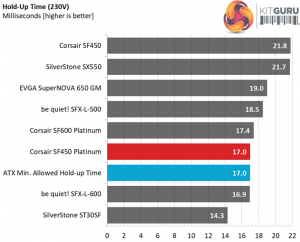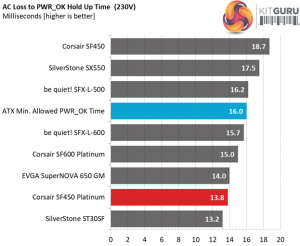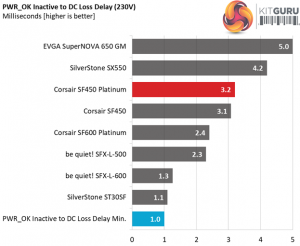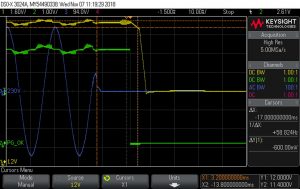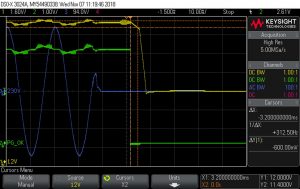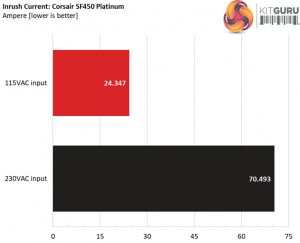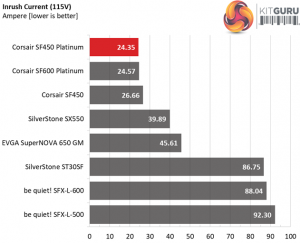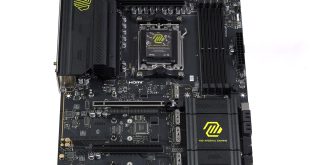To learn more about our PSU tests and methodology, please check out How We Test Power Supply Units.
Primary Rails And 5VSB Load Regulation
Load Regulation testing is detailed here.
Hold-Up Time
Our hold-up time tests are described in detail here.
The oscilloscope screenshots that we took during the hold-up time measurements:
The hold-up time is right on spot at 17ms, however the power ok signal is shorter than 16ms. It is accurate at least. In the scope screenshots we notice a low frequency ripple pattern on the standby signal, which is identical to the oscillation of the +12V rail.
Inrush Current
For details on our inrush current testing, please click here.
The inrush current might be low with 115V, but is on the high side with 230V.
Load Regulation And Efficiency Measurements
The first set of tests reveals the stability of the voltage rails and the SF450’s efficiency. The applied load equals (approximately) 10 to 110 percent of the power supplies maximum load in increments of 10 percentage points.
We conducted two additional tests.
During the first, we stressed the two minor rails (5V and 3.3V) with a high load, while the load at +12V was only 0.1A. This test reveals whether a power supply is compatible with Intel’s C6/C7 sleep states or not. In the second test, we determined the maximum load the +12V rail could handle with minimal load on the minor rails.
| Test # | 12V | 5V | 3.3V | 5VSB | DC/AC (Watts) | Efficiency | Fan Speed (RPM) | PSU Noise (dB[A]) | Temps (In/Out) | PF/AC Volts |
| 1 | 1.925A | 1.981A | 1.969A | 0.995A | 44.859 | 84.997% | 0 | <6.0 | 44.32°C | 0.870 |
| 12.081V | 5.051V | 3.350V | 5.026V | 52.777 | 39.82°C | 115.05V | ||||
| 2 | 4.841A | 2.971A | 2.955A | 1.195A | 89.381 | 89.567% | 0 | <6.0 | 45.61°C | 0.937 |
| 12.080V | 5.051V | 3.349V | 5.021V | 99.792 | 40.51°C | 115.05V | ||||
| 3 | 8.152A | 3.467A | 3.435A | 1.396A | 134.485 | 91.120% | 0 | <6.0 | 46.63°C | 0.960 |
| 12.080V | 5.050V | 3.348V | 5.015V | 147.591 | 41.19°C | 115.05V | ||||
| 4 | 11.467A | 3.963A | 3.944A | 1.597A | 179.685 | 91.657% | 1311 | 13.8 | 41.86°C | 0.974 |
| 12.076V | 5.049V | 3.347V | 5.010V | 196.040 | 47.86°C | 115.05V | ||||
| 5 | 14.450A | 4.953A | 4.931A | 1.799A | 224.988 | 91.785% | 1393 | 15.7 | 42.15°C | 0.981 |
| 12.075V | 5.048V | 3.346V | 5.004V | 245.126 | 48.48°C | 115.05V | ||||
| 6 | 17.362A | 5.946A | 5.918A | 2.001A | 269.486 | 91.049% | 1547 | 18.9 | 42.66°C | 0.877 |
| 12.077V | 5.047V | 3.345V | 4.998V | 295.980 | 49.93°C | 115.05V | ||||
| 7 | 20.342A | 6.938A | 6.906A | 2.204A | 314.785 | 91.078% | 1728 | 22.0 | 43.00°C | 0.987 |
| 12.077V | 5.046V | 3.345V | 4.993V | 345.623 | 50.83°C | 115.04V | ||||
| 8 | 23.326A | 7.931A | 7.894A | 2.407A | 360.106 | 90.707% | 1934 | 25.3 | 43.94°C | 0.989 |
| 12.076V | 5.046V | 3.344V | 4.987V | 396.998 | 52.40°C | 115.04V | ||||
| 9 | 26.707A | 8.427A | 8.376A | 2.408A | 405.004 | 90.376% | 2174 | 28.3 | 44.52°C | 0.990 |
| 12.075V | 5.045V | 3.343V | 4.984V | 448.130 | 53.55°C | 115.04V | ||||
| 10 | 30.025A | 8.926A | 8.887A | 2.510A | 449.706 | 89.918% | 2706 | 34.5 | 45.67°C | 0.991 |
| 12.073V | 5.044V | 3.341V | 4.980V | 500.128 | 55.86°C | 115.04V | ||||
| 11 | 33.744A | 8.926A | 8.892A | 2.512A | 494.517 | 89.481% | 3184 | 38.7 | 46.88°C | 0.992 |
| 12.070V | 5.043V | 3.341V | 4.978V | 552.651 | 57.67°C | 115.04V | ||||
| CL1 | 0.138A | 12.002A | 11.999A | 0.000A | 102.476 | 86.890% | 742 | 6.5 | 42.21°C | 0.948 |
| 12.095V | 5.050V | 3.350V | 5.028V | 117.938 | 48.51°C | 115.05V | ||||
| CL2 | 37.509A | 1.002A | 1.001A | 1.000A | 466.102 | 90.568% | 2648 | 34.3 | 45.90°C | 0.991 |
| 12.069V | 5.046V | 3.342V | 5.005V | 514.642 | 55.83°C | 115.04V |
The load regulation is super tight on all rails. Great Wall managed to greatly improve the original, Gold platform, in this section.
With 20% and 50% load levels the SF450 is not able to reach the required efficiency levels that the 80 PLUS Platinum standard asks for, while with full load it is close to the Titanium mark of 90%. We should stress that we conduct those tests at a very high ambient, contrary to the 80 PLUS organisation, so it is natural to measure lower efficiency levels. Under lower temperatures the efficiency will be increased in all cases.
The fan profile is highly relaxed and we have to push the unit very hard, and beyond its official limits, to make the fan spin at close to 3200 RPM where its output noise doesn't breach the 40 dB(A) mark.
 KitGuru KitGuru.net – Tech News | Hardware News | Hardware Reviews | IOS | Mobile | Gaming | Graphics Cards
KitGuru KitGuru.net – Tech News | Hardware News | Hardware Reviews | IOS | Mobile | Gaming | Graphics Cards


